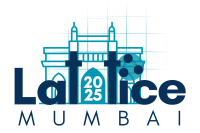Speaker
Description
We present an extended version of the k-Shape method, originally developed for time-series clustering, and apply it to lattice simulations of the finite-temperature and finite-density (1+1)-dimensional Gross–Neveu model. The method has been generalized from real to complex scalar fields and from one-dimensional to multidimensional configurations, allowing a detailed analysis of spatially varying condensates.
By employing the extended k-Shape method, we can extract detailed information about phase structure that is not easily accessible through conventional techniques. In the uniform, chiral-symmetry-broken phase, the phase structure can be characterized sufficiently by the expectation value of the configuration. Near the phase boundary, however, the k-Shape method reveals smooth variations in the configuration pattern, providing a sensitive probe of the transition region.The extended k-Shape method can analyze spatial dependencies that do not resemble simple sinusoidal waves. This makes it particularly suitable for identifying nontrivial spatial patterns that emerge in inhomogeneous condensate. In kink-like configurations, for example, the minimum of the correlation function is not necessarily negative, indicating a richer structure than can be captured by traditional correlation analysis.
These results demonstrate that the k-Shape approach offers a powerful and versatile framework for extracting detailed features of phase transitions and for exploring the interplay between uniform and inhomogeneous condensate in lattice field theories.
| Parallel Session (for talks only) | QCD at nonzero temperature and density |
|---|

